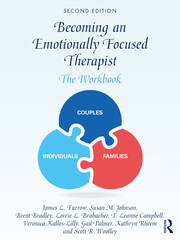Becoming an Emotionally Focused Therapist: The Workbook

Book Details
- Publisher : Routledge
- Published : 2022
- Cover : Paperback
- Pages : 424
- Category :
Individual Psychotherapy - Category 2 :
Family, Couple and Systemic Therapy - Catalogue No : 96262
- ISBN 13 : 9780367483425
- ISBN 10 : 0367483424
Reviews and Endorsements
"The second edition of Becoming an EFT Therapist: The Workbook extends and updates an exceptionally useful book. Not only is this the definitive workbook for learning emotionally focused couple therapy, it also covers the recent developments of Johnson’s attachment theory in practice treatment model in individual and family therapy. It provides the kind of hands-on how to do it information that therapists need and look for. A wonderful resource either in conjunction with a training program or as part of a therapist's individual development, this workbook has great value not only for those who wish to become practitioners of EFT but also for all therapists." - Jay Lebow, Ph.D., ABPP.; Senior Scholar and Clinical Professor; Editor, Family Process; The Family Institute at Northwestern and Northwestern University, Evanston IL
"If you want to internalize the feel and the craft of EFT, this is your book. It takes you inside sessions, making you think about how you would respond and how you can go deeper. And this updated workbook shows the power of EFT to heal individuals and families as well as couples. Any therapist on the planet will benefit from reading it." - William J. Doherty, Ph.D.; professor of family social science at the University of Minnesota and co-author of Helping Couples on the Brink of Divorce: Discernment Counseling for Troubled Relationships
"Whenever I teach or supervise EFCT, I always use the Workbook. I have not found a better book to help EFT therapists learn how-to-do-it. This second edition only intensifies that recommendation. In some ways the new edition is essentially a whole new book. There are new chapters on EFT with individuals (EFIT); the family chapter (EFFT) has been expanded; the approach of the EFT Tango is explicated; and the application of EFT to trauma is more in-depth. However, this second edition has maintained the central strength of its predecessor—its ongoing involvement with the reader as an active learner—asking the reader to state what they are learning while they are learning it, to apply various procedures to imagined cases, and to reflect on the personal ramifications of the material. The Workbook makes the learning come alive and shortens the bridge between theory and practice. For any therapist who is floundering with, "but what do I say now?" this is a must-read." - Hanna Levenson, Ph.D.; Professor, Wright Institute, Berkeley, CA.

